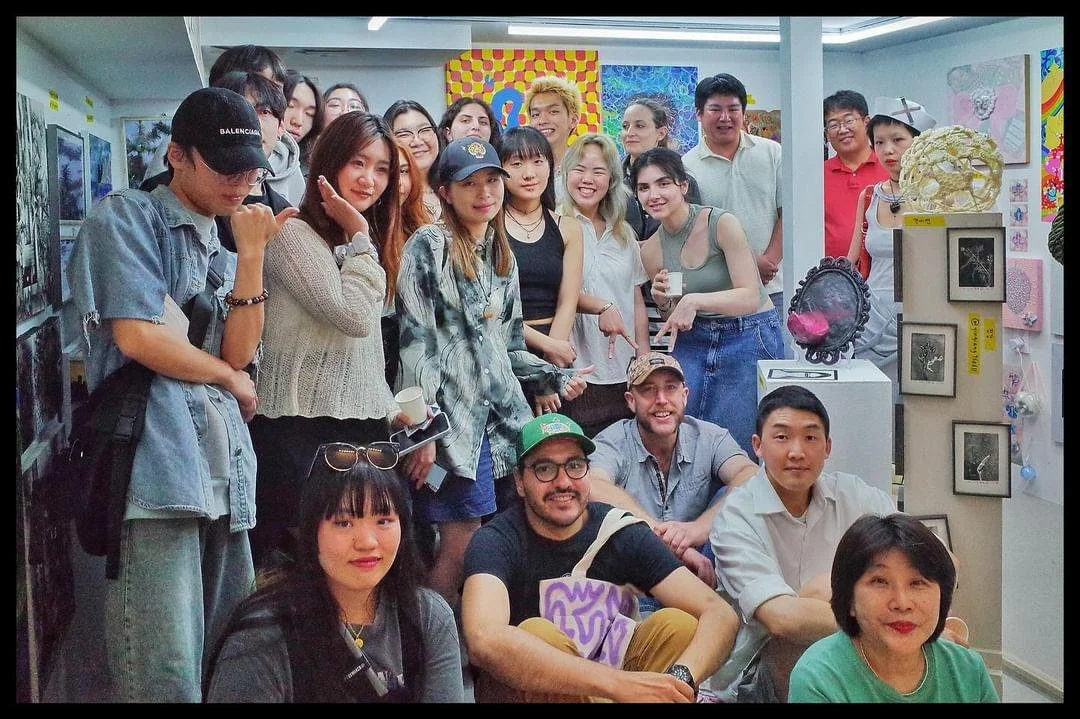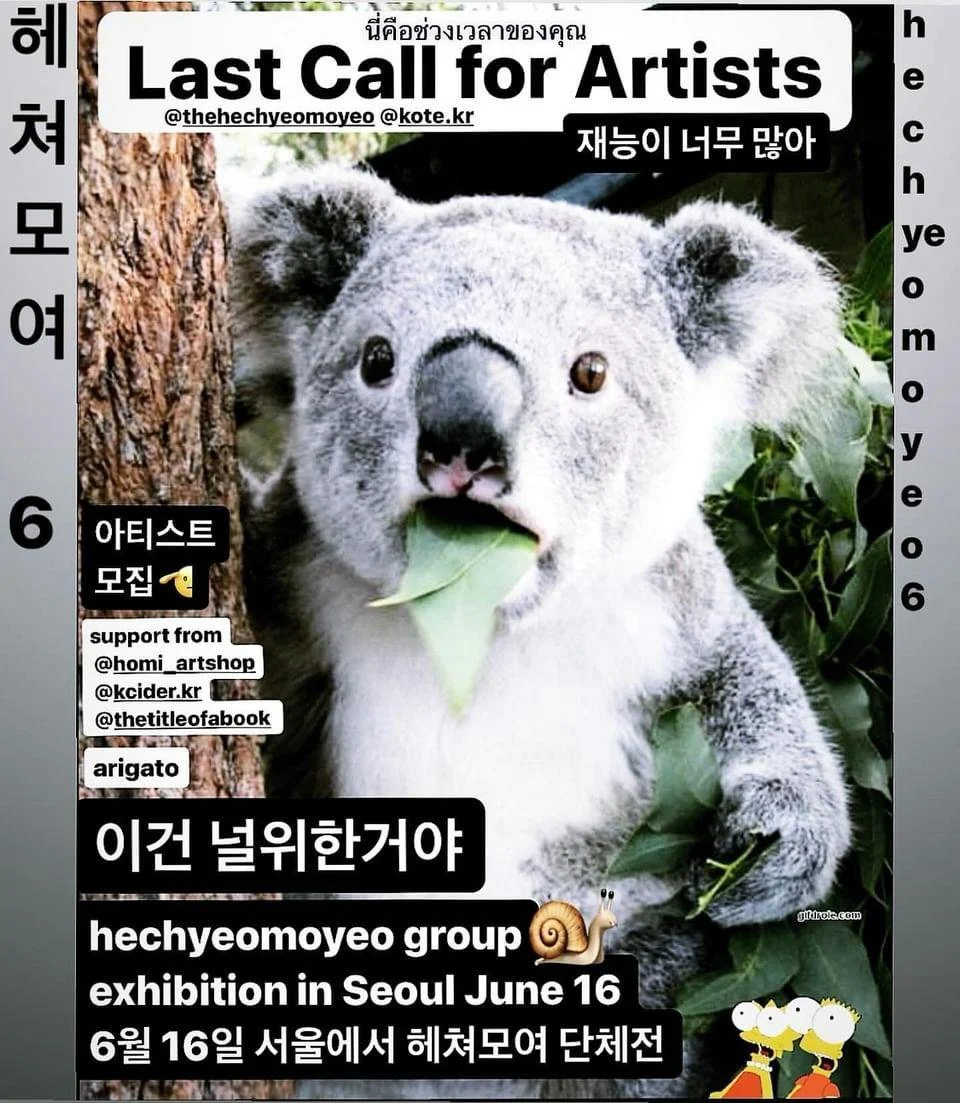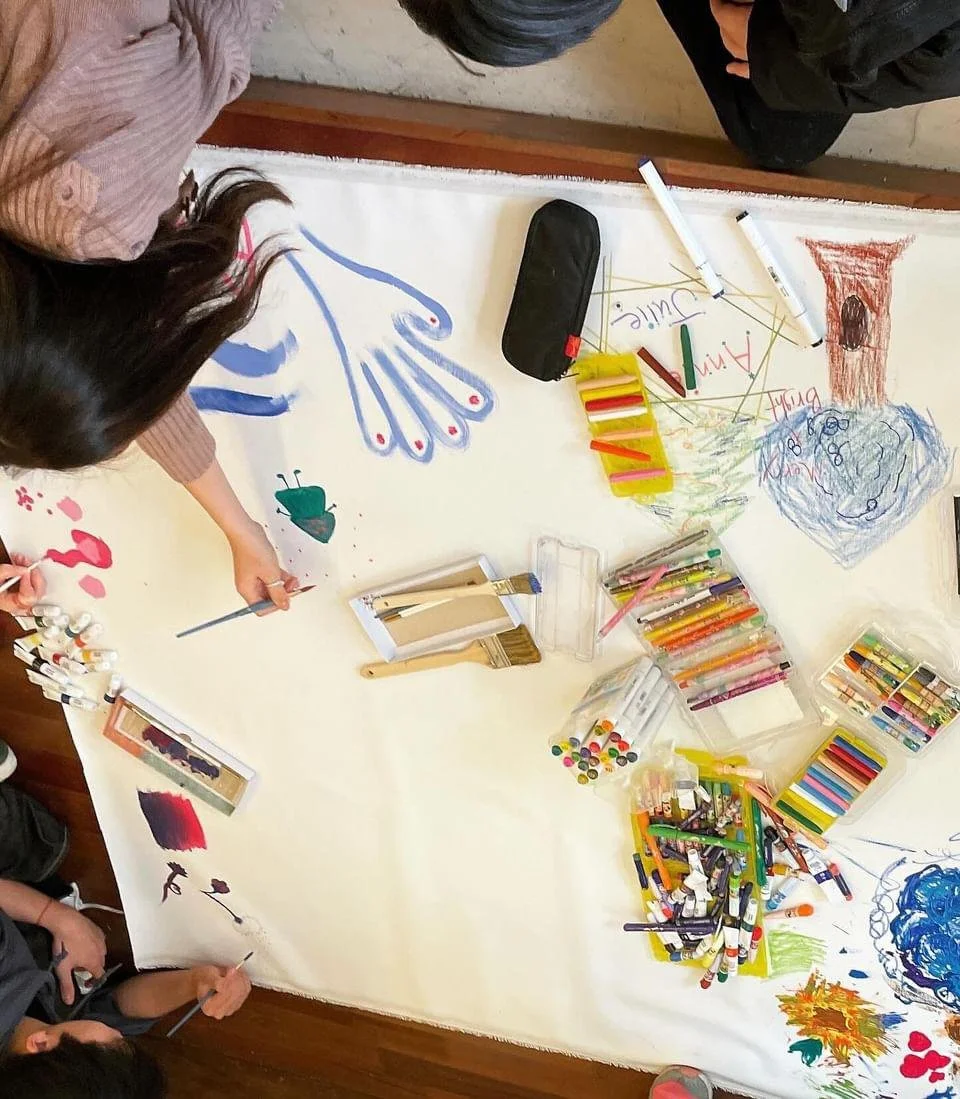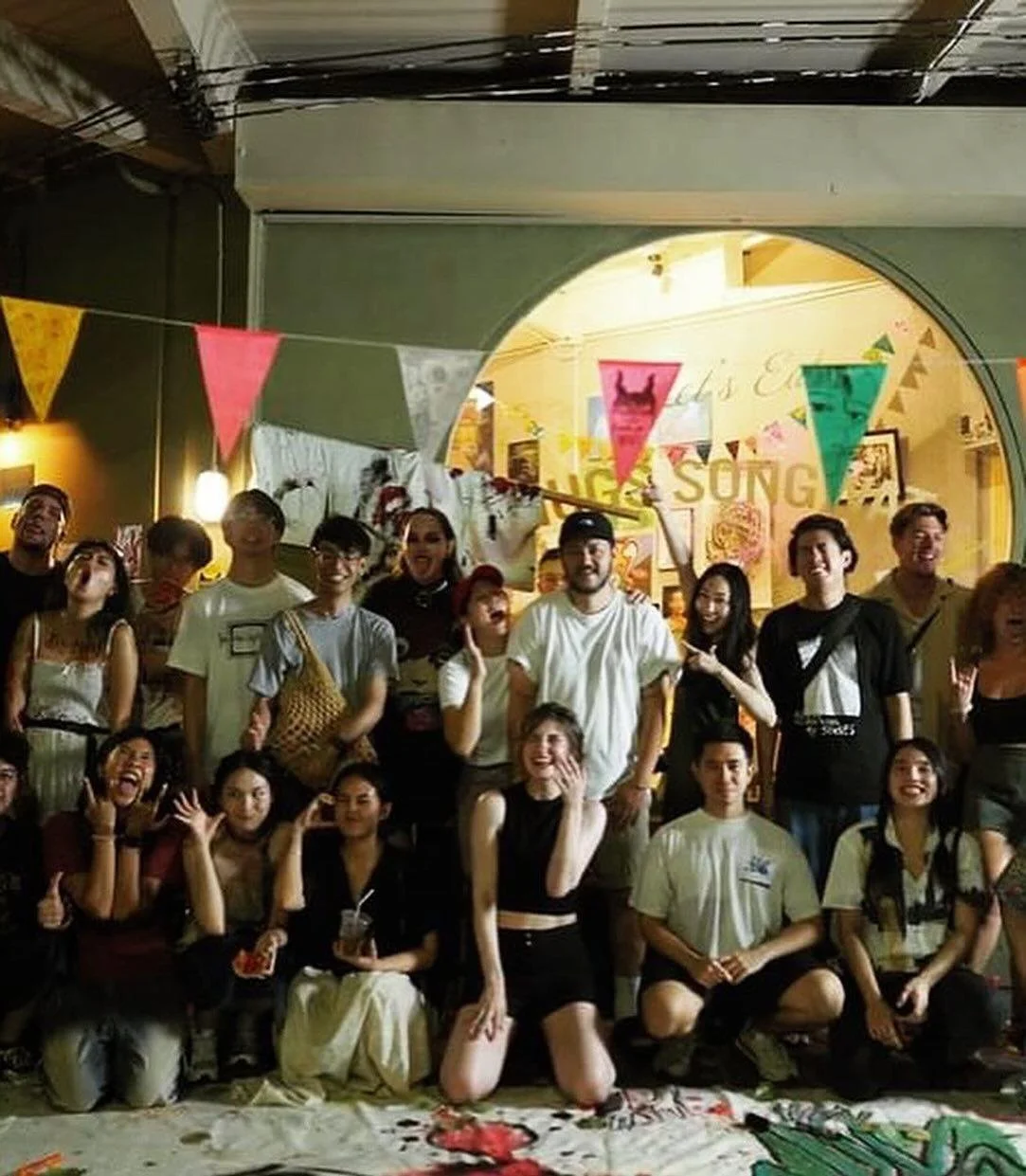How The Hechyeomoyeo's art parties are changing Seoul's creative landscape
By Jamie Finn (@jamiefinn2209)
In Seoul, a new art exhibition project called The Hechyeomoyeo is gaining popularity. With an emphasis on community, atmospheric events, and a "more is more, actually" philosophy, the project has grown rapidly in just a short space of time. Here, project founder Neil Wheelock Deforest Smith talks to us about what makes The Hechyeomoyeo such an exciting presence in Seoul's art scene.
As I stand in front of a large-form pencil drawing of a small-faced, blobbish man named Bob, someone I don't know comes over to me. "What do you think it means?" I dust off my art history degree and give an overly obtuse answer about "playing with expectations". "I think it's just a funny sketch," he explains. We laugh and talk about other pieces over wine. The atmosphere here at The Hechyeomoyeo doesn't just allow for this kind of exchange; it encourages it. The exhibition feels as much like a party as it does an exhibition - not that the two need to be separated. There are people taking pictures, naturally, but they're in the minority. Most people seem more interested in talking about what's in front of them than posting it to Instagram.
The Hechyeomoyeo is all about removing barriers from artists and exhibition goers. They act as a celebration of a kind of boundless creativity, where there is no right and wrong, no good and bad. Here, all forms of expression and aesthetics are welcome.
The project was founded by Neil Wheelock Deforest Smith, who got the idea for The Hechyeomoyeo while navigating the possibilities and the limitations of Seoul's art community. "I was given the opportunity to show my artwork a few times in Seoul last year. Soohye hosted an event in Seoul called the Mayfly, where she brought together a diverse collection of local artists. I was then invited to the Yongsan Fine Arts Festival by James Beckwith. The event hosted a ton of artists, both foreigners and Koreans. It seemed like the art scene in Seoul had a lot of space for Korean artists and a few where foreigners could participate - but not many that mixed the two. These two experiences really inspired me."
"In June or July of 2023," he expands, "I got together with two artists, Jeong Lera and James Beckwith, and we hosted an afternoon where we brought together a few Korean artists and a few foreign artists. Here, the artists were present and could engage the public. The event was successful, and so about two months later, when Polite Galleries offered me a solo show, I asked them if I could host a group show where I mixed Korean, foreign, and international artists. That show had 34 artists, including a group of artists I had met whilst in Malaysia. This was the first Hechyeomoyeo. When artists came, they wanted to know when they could be at the next one. This was back in August."
Poster for their upcoming exhibition.
Since then, the project has exploded. Their most recent Seoul instalment featured over 190 artists, and they have even taken the project abroad, having recently hosted an exhibition in Thailand. "Through The Hechyeomoyeo, there is a space for absolutely anyone to show their work inside of Korea. So, now it's time to experiment with bringing their artwork out of the country."
But why Thailand? "I chose Thailand because I like motorbikes," he laughs. "People are also pretty chill down there. So I went there in January and told a bunch of people what we were doing in Seoul. I found a place willing to host us, and I got about 25 Thai artists ready to exhibit their art next to artists from Korea."
A core ethos of The Hechyeomoyeo, a key reason for its growth, is trying to subvert the art world's ever-stifling filter system. This is especially true in a city like Seoul, which, while having some obvious highlights, can all too often be limited by commercialism and conservatism. "The art scene is controlled by gallery spaces," he explains, "which have an obvious motivation to sell works. So, I wanted there to be a place where artists could exhibit their pieces without being compelled to show works that were considered sellable. I consider it to be in line with some free speech principles. I don't require any previous experience, any resume or formal portfolio. I don't even ask them to show me what they want to hang on the wall. I trust artists will just pick the artwork they want and bring it to the space."
You might expect that gathering 190 artists for an exhibition might be a mammoth task, but Neil says it is a little easier than you might expect. "I use social media to hunt them down, or they find me. Artists are eager to find platforms. So artists, especially foreign artists, are thrilled to find a spot where they don't have to fill out paperwork in Korean or pay a ton of money to show their artwork."
In addition to removing the barriers of entry, rejecting commercialism is another core aspect of The Hechyeomoyeo. "I don't really know anything about selling art," he says. "Neither was I extremely interested in that. So I don't want to tell people that's what we were doing. My idea about The Hechyeomoyeo has always been more political. There should be a diverse, inclusive space where artists are encouraged to "say" what they want to say and make art however they want. It's also a space where we can create and cultivate community, meet people for future collaborations, and introduce new artists to other artists and people already on the scene. If we put a price tag on the wall and made our focus monetisation, well, all of that kinda gets compromised or forgotten about."
"We also make the space a living studio space. When I secured the venue, I let everyone know that they were allowed to draw, paint, write, and do whatever they wanted inside the exhibition. It's a place where people can feel free to experiment or just play with some paint. But if there is all this talk of money in the air, it's not as fun, ya know?"
Neil has alluded to what may be the project's special sauce - the electric, communal atmosphere. There is a feeling at The Hechyeomoyeo that you're part of the fabric of Seoul's art scene. Even as just an attendee, you don't feel like a bystander to culture there, but an active participant. "We put special attention on achieving this energy. My approach is this: if I want people to feel comfortable painting or drawing in the exhibition, I do those things first. If I want people to be ok with showing "questionable" or untraditional or untechnical art, well, you should see some of the stuff I make. I also think all the people who come every day and create in the space and the many volunteers we have do a great job of being welcoming to anyone who visits."
The Hechyeomoyeo has even started branching into other fields by including music at their events, such as Platform favourite Fat Hamster. "That guy has killer energy. He brought the kind of spirit that fits perfectly with our community. I also think of our exhibition as cultural, not simply focused on the visual arts. We also had an open mic with comedy and performance arts, artist talks, life drawing with a model. I welcome anything that has to do with creative energy into The Hechyeomoyeo space.
In fact, Neil says this sense of collaboration is a crucial part of his art journey so far and is the first advice he gives to anyone looking to get involved in Seoul's creative community. "If I have had success, it's probably because most of my projects are collaborative. Working with other people opens artists up to new audiences and takes their art in all kinds of different directions and dimensions. Doing so can be scary because we lose the illusion of control or our selfish pursuits. But, in my experience, it works. Other artists are not competition. If anyone is your competition, it's you. Other artists are your allies."
So, have Hechyeomoyeo artists stood out for Neil? He stays diplomatic. "I have many favourites, but I don't really want to say who," he laughs. "Mostly, I am proud of the artists who show up and are showing their work for the first time. I know how scary it was for me. It took a lot of not listening to myself in order to do it. I also like the artists who show things that are, let's say, socially unacceptable. I mean, if you show up with an oil painting in a nice wooden frame, no one asks whether it is art or not. But some people have shown really interesting pieces that ask the question of what is ok to put in a gallery and what isn't. These are some of my favourites."
While Neil might be reluctant to share his personal choices for Hechyeomoyeo participants, he does highlight his own voyage into art. "When I was teaching in a hagwon I wanted to die. I knew I had to give up my plans to be a teacher, but I didn't really know what else to do. I was reading the Principia Discordia around this time and decided I could start producing cultural artefacts on the copy machine at work. This also made me feel like I was taking an impotent jab at the private education system by wasting their recycled paper and toner. I produced a body of artwork consisting of about 2,100 original copies I had whilst at my job. It was collage-like a4 prints incorporating my writings, student drawings, my lunch, textbooks, homework, garbage I found on the street, basically anything I could put on the copy machine. This was my first serious artistic pursuit."
The next steps for The Hechyeomoyeo are predictably open. Neil has some ideas but is keen to let the community shape the project's future. "I try to ask a lot of people what to do next, which is tough because there are lots of people and just as many opinions. I always like doing new things every time I do a project, so I will be on the lookout for what kinds of new elements we can incorporate into our exhibition. If anyone has a suggestion, my DMs are open."
For more information on The Hechyeomoyeo, follow them here.
Follow Neil here.






